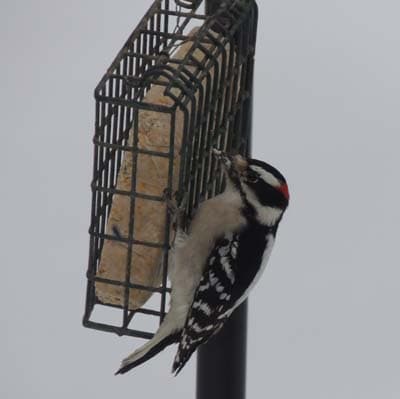
If you have a downy woodpecker in your backyard, you’re certainly going to be thrilled. Bird watchers are fascinated with woodpeckers. Perhaps it goes back to the cartoon “Woody Woodpecker”. Woody was a fun and loving character. Now that he is in your backyard, learn the downy woodpecker’s diet so he makes your backyard his home.
Bird watchers seek to attract woodpeckers to their yards. There are over 200 species. Among the most common is the Downy Woodpecker. He (or she) can be seen year-round, attracted by a suet feeder. The Downy Woodpecker and his closely related cousin the Hairy Woodpecker are non-migratory birds. They are native residents of the Continental US, Canada, and Alaska.
Have you ever seen or heard them pecking on gutters or the metal flashing on chimneys!? It can be irritating. Apparently, they do this simply because they like the sound.
Adult Downy Woodpeckers are easily identified. They have a black head with a bright red cap and white around the neck. Their beaks are long and thin. The backs and wings are white and black. The stomach is white. Adult downy woodpeckers grow to 5.5 to 6.5 inches.
Most often, you see them by themselves or with another woodpecker, likely a mate, as they search for food. If you see them in small groups, the groups are called a “descent”.
Did You Know? Woodpeckers have very long tongues, about twice as long as their bills.
Downy Woodpeckers live about 3-5 years.
These birds are at home in open woodlands, preferring deciduous trees. They can be found at the edges of the woods, among brush and weeds.
They are at home in parks as well as in your backyard. To attract them, place suet a couple of places in your yard, where they can be observed.

The Downy Woodpecker’s diet is about 3/4 insects. They peck at the bark of a tree in search of ants, beetles, grubs, and other insects. Usually, it is a dead tree. Additionally, they occasionally consume tree sap. But they do not eat the wood. Also, Woodpeckers eat birds’ eggs.
You can attract woodpeckers to your backyard feeder with a suet containing fruit or seeds.
Did You Know? While woodpeckers pound their beaks into wood in search of insects, they do not get headaches.
Downy woodpeckers mate in early spring. Both the male and female work together to peck a hollow nest inside of a tree. the opening is about 1 1/2 inches in diameter. The female lays 3-8 eggs, which hatch about 12 days later. Hatchlings remain in the nest for 18-21 days.
Birds of prey are this woodpecker’s greatest enemy. Rats and cats are also predators.
Additionally, snakes and squirrels will attack the nest.
Here is much more information on how to attract birds to your backyard:

©1999-2024 GardenersNet.Com, All Rights Reserved